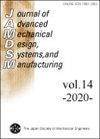A look-ahead AGV scheduling algorithm with processing sequence conflict-free for a no-buffer assembly line
IF 1
4区 工程技术
Q4 ENGINEERING, MANUFACTURING
Journal of Advanced Mechanical Design Systems and Manufacturing
Pub Date : 2023-01-01
DOI:10.1299/jamdsm.2023jamdsm0063
引用次数: 0
Abstract
As a critical part of modern industry, assembly line plays an important role in mass-producers because of its great advantages in production efficiency and construction cost. With the increasing demand for customized production, the fixed processing flow of assembly line is becoming more and more difficult to adapt to the changes. The introduction of automated guided vehicles (AGVs) as the material handling equipment improve the flexibility of assembly line, which also derives a complex AGV scheduling problem. In the recent years, because of the limitation in place, no-buffer assembly line appears in some plant, which derives a new problem, processing sequence conflicts (PSC). This paper builds a Petri net model to deal with the AGV scheduling problem and processing sequence conflicts in the no-buffer assembly line. A genetic algorithm based look-ahead scheduling algorithm (LASA) with processing sequence conflict-free is developed to minimize the total processing makespan in a no-buffer assembly line by introducing prospective tasks. Chain task strategy is integrated to further improve the performance of LASA in the case of AGVs deficiency. Two groups of simulation experiments are carried out to test the performance of the proposed algorithms in different scenarios. The results show the proposed algorithm has advantages in processing makespan, AGVs’ efficiency and machines’ efficiency. A robot experiment is carried out in a real no-buffer assembly line. The processing makespan of experiment is close to the theoretical lower bound.无缓冲装配线加工顺序无冲突的前瞻性AGV调度算法
装配线作为现代工业的重要组成部分,由于其在生产效率和建设成本方面的巨大优势,在大规模生产中发挥着重要作用。随着定制化生产需求的不断增加,装配线固定的加工流程越来越难以适应这种变化。自动导引车(AGV)作为物料搬运设备的引入,提高了装配线的灵活性,同时也衍生出复杂的导引车调度问题。近年来,由于存在一定的限制,某些工厂出现了无缓冲装配线,由此产生了加工顺序冲突问题。针对无缓冲装配线中AGV调度问题和加工顺序冲突问题,建立了Petri网模型。提出了一种基于遗传算法的加工顺序无冲突的预见性调度算法,通过引入前瞻性任务使无缓冲装配线的加工总完工时间最小化。结合链式任务策略,在agv不足的情况下进一步提高LASA的性能。通过两组仿真实验,验证了所提算法在不同场景下的性能。结果表明,该算法在处理最大完工时间、agv效率和机器效率方面具有优势。在真实的无缓冲装配线上进行了机器人实验。实验的加工时间接近理论下界。
本文章由计算机程序翻译,如有差异,请以英文原文为准。
求助全文
约1分钟内获得全文
求助全文
来源期刊
CiteScore
2.00
自引率
0.00%
发文量
25
审稿时长
4.6 months
期刊介绍:
The Journal of Advanced Mechanical Design, Systems, and Manufacturing (referred to below as "JAMDSM") is an electronic journal edited and managed jointly by the JSME five divisions (Machine Design & Tribology Division, Design & Systems Division, Manufacturing and Machine Tools Division, Manufacturing Systems Division, and Information, Intelligence and Precision Division) , and issued by the JSME for the global dissemination of academic and technological information on mechanical engineering and industries.

 求助内容:
求助内容: 应助结果提醒方式:
应助结果提醒方式:


